This simple Japanese Sesame Sauce (Goma Dare) is creamy, flavorful, and savory. Use it as a dipping sauce for shabu shabu (Japanese hot pot) or try it with steamed vegetables, cold or hot tofu, green salad, and somen or udon noodles. The possibilities are limitless!
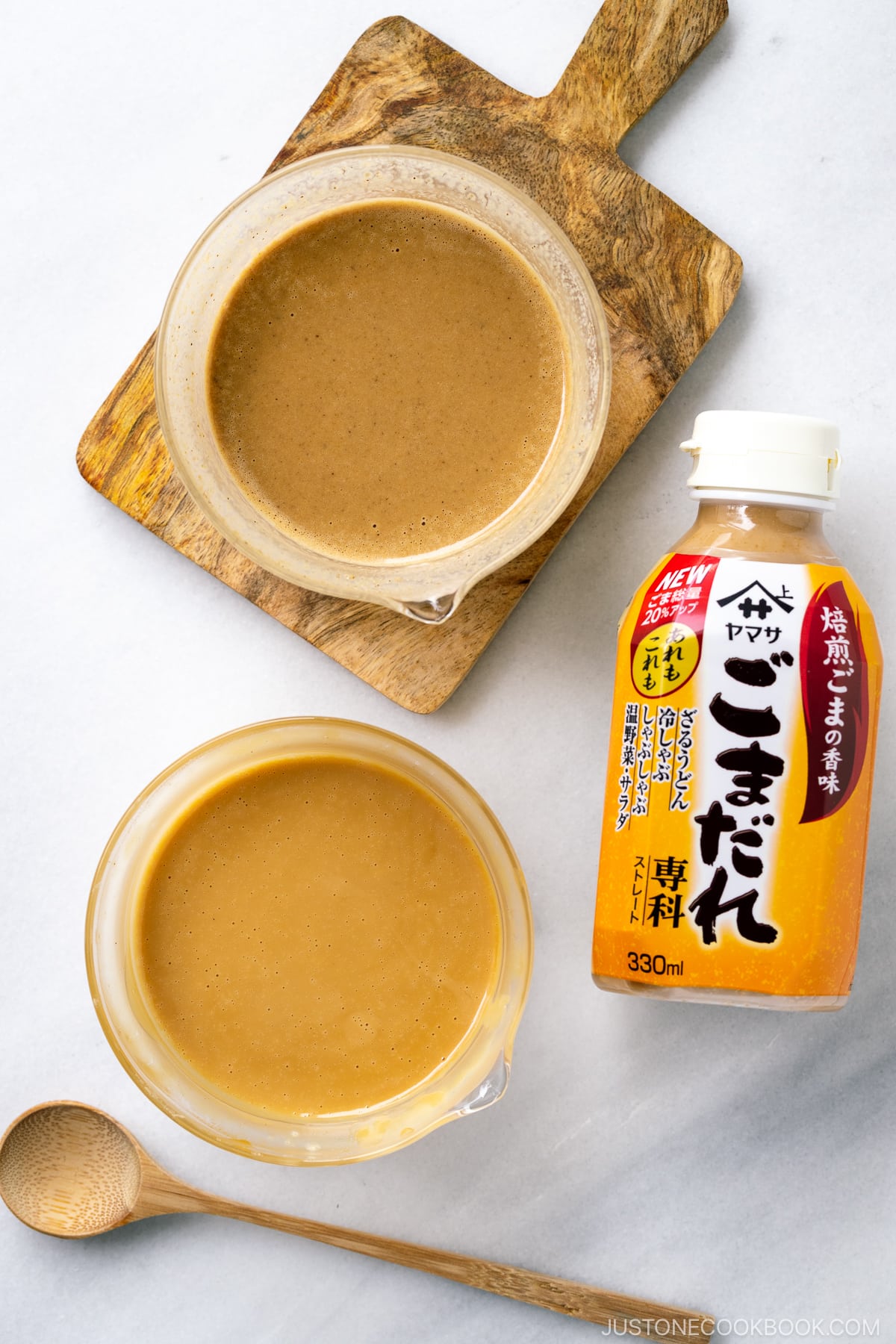
Japanese Sesame Sauce, or Goma Dare (胡麻だれ), is one of the dipping sauces typically served with the Japanese hot pot, Shabu Shabu. However, there’s so much more to this flavorful and creamy condiment. It is as wonderful as a dressing for salads and noodle dishes, or as a sauce to pair with grilled or steamed veggies and tofu!
Let me show you how make Goma Dare from scratch, with just a few simple ingredients.
Table of Contents
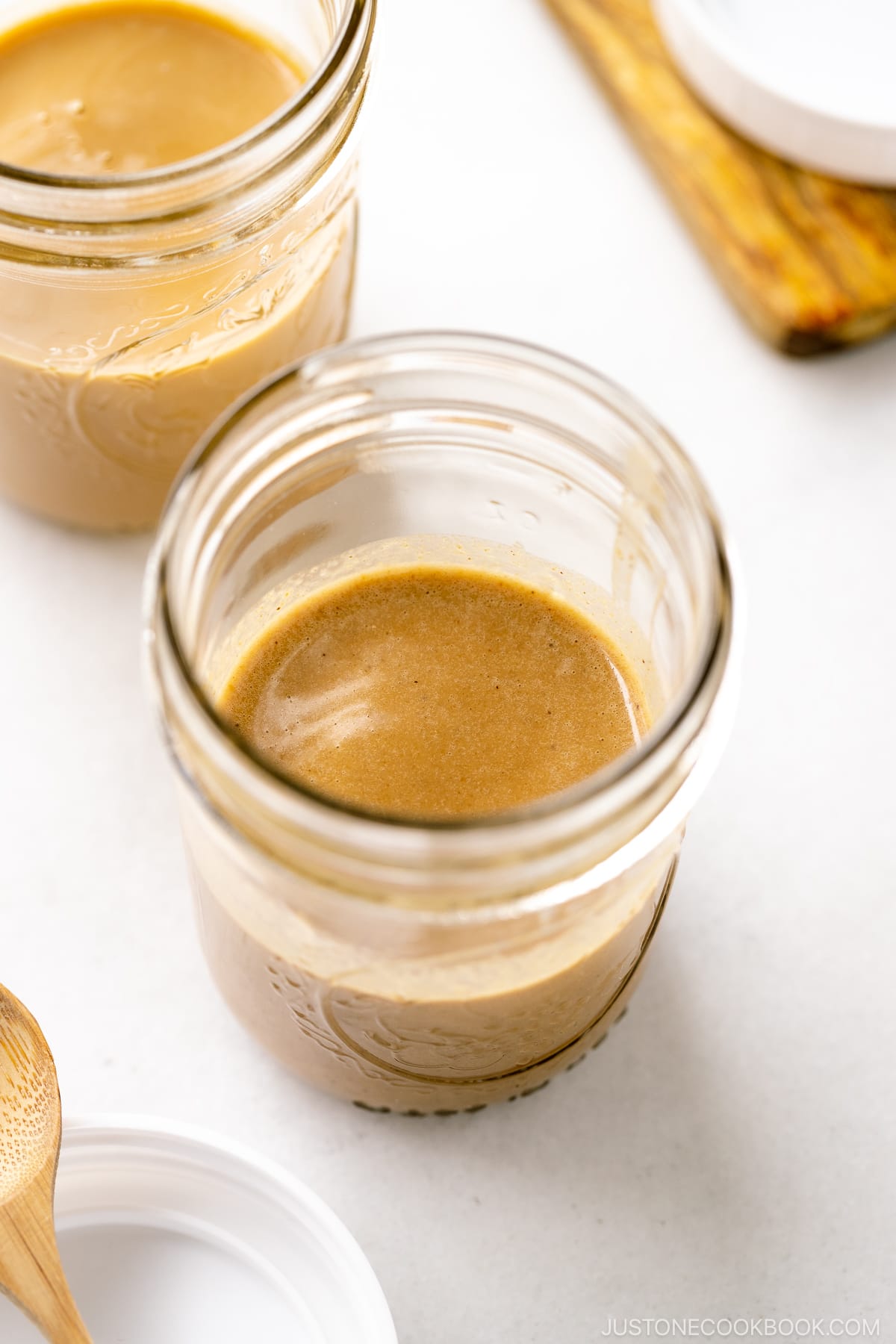
What is Goma Dare?
Goma (胡麻, ごま) refers to sesame seeds, while Dare or Tare (たれ) translates to sauce in Japanese. Pronounced as [Goh-mah Dah-Leh], this delectable sauce is made from Japanese sesame paste, sugar, soy sauce, rice vinegar, and dashi (Japanese soup stock).
Its consistency is smooth and creamy, offering a harmonious blend of nutty, sweet, salty, and umami flavors. It enhances the taste of whatever you’re dipping or dressing without overshadowing the inherent flavors of the food.
Whenever I prepare Goma Dare for Shabu Shabu, I make extra to refrigerate for later use in various dishes.
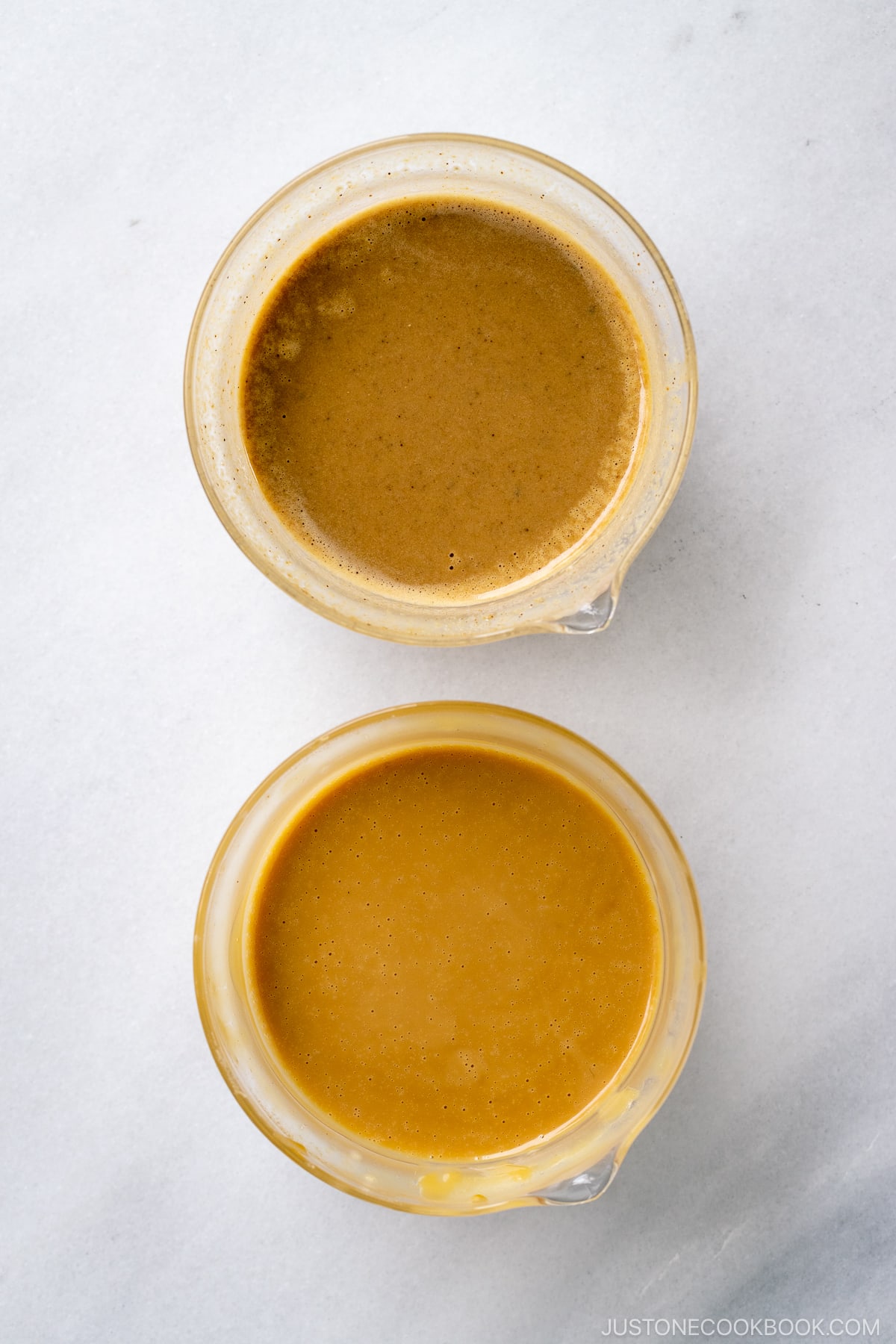
Ingredients for Goma Dare
You can find the ingredients’ measurements in the recipe card below.
- Japanese sesame paste (nerigoma) – More about it below.
- Sugar
- Soy sauce
- Rice vinegar – Try to use rice vinegar as it’s a lot milder than other kinds.
- Dashi (Japanese soup stock) – You can make it from scratch (Kombu + Bonito Dashi or Vegan Dashi) or use a quick and easy Dashi Packet (I used this method for this recipe). You can also make dashi using water and Dashi Powder.
- Salt
- All you need to do is to mix everything. I recommend mixing the sesame paste and sugar first and making sure the sugar is completely dissolved before adding any liquid ingredients.
- Then, add the soy sauce and rice vinegar, followed by the dashi.
- Taste it and adjust it with salt.
What is Nerigoma (Japanese Sesame Paste)?
Nerigoma (ねりごま) is a Japanese sesame paste made by grinding whole toasted white sesame seeds into a paste. There are both white sesame and black sesame pastes, so make sure to choose the white sesame paste for this recipe.
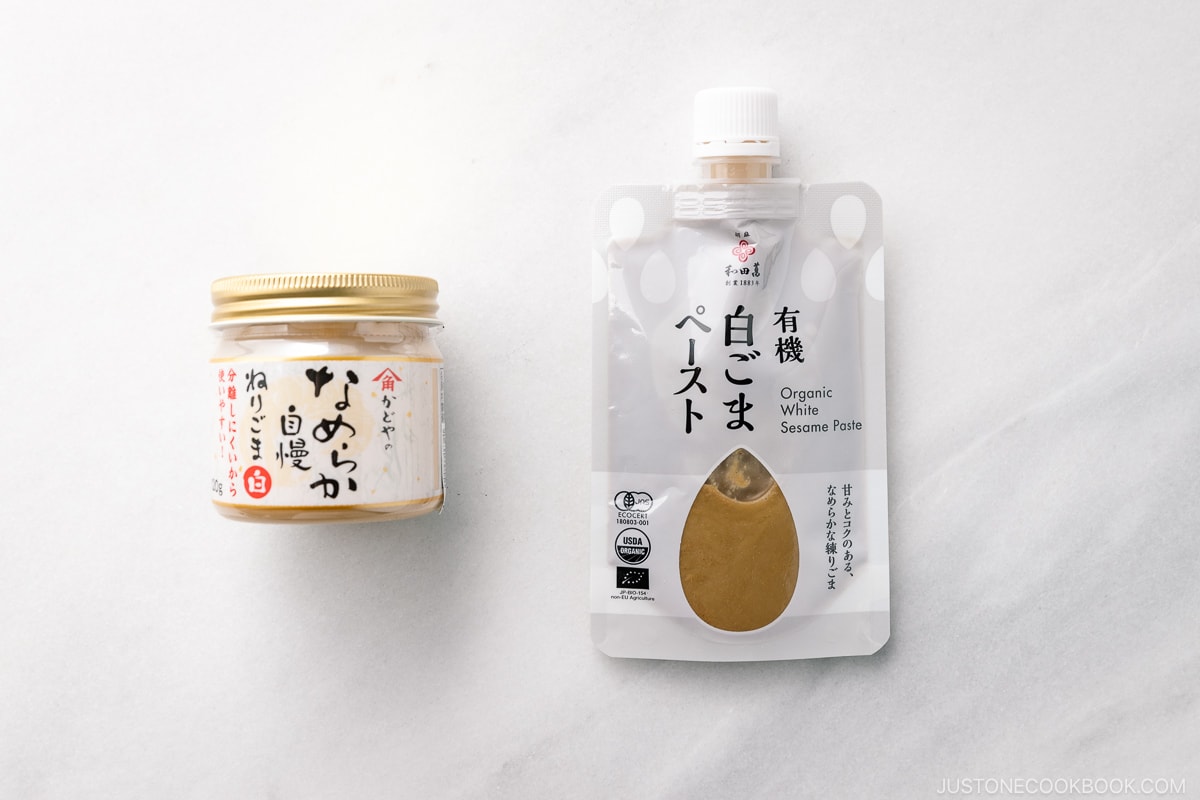
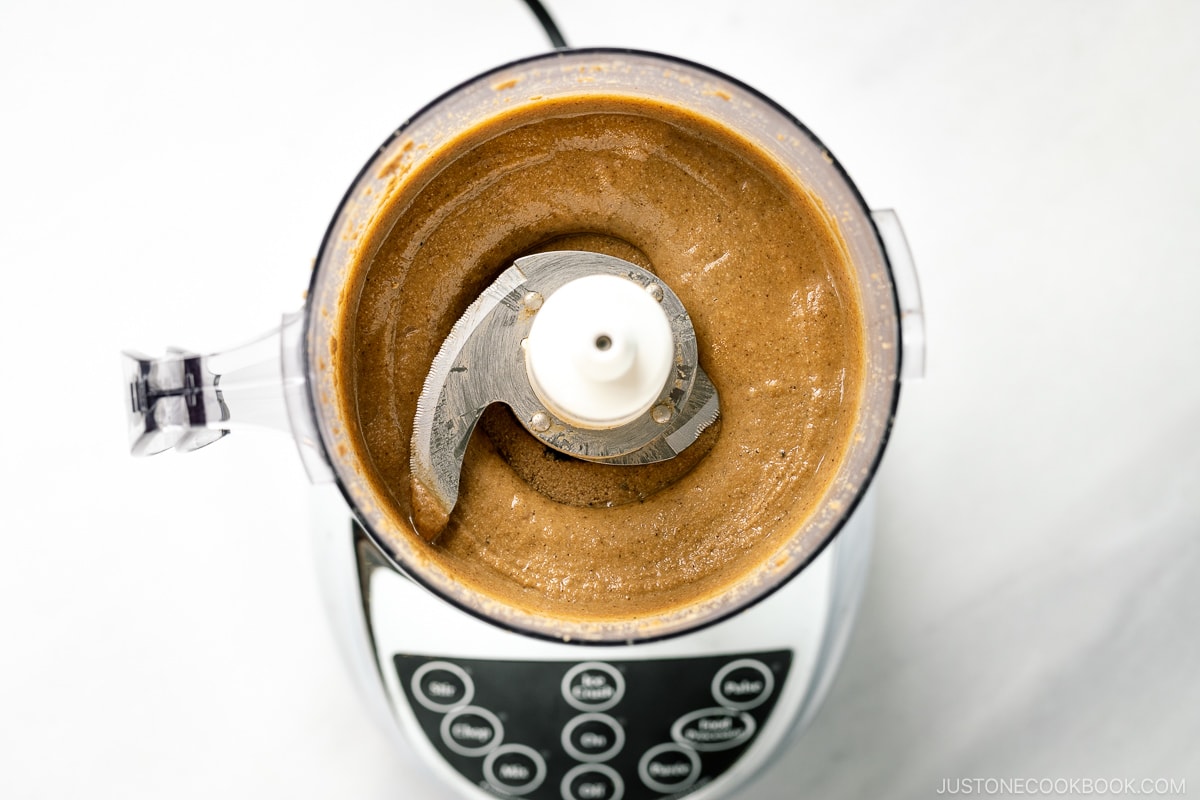
Where to Find Nerigoma
- You can find nerigoma on Amazon (here and here) or in Japanese grocery stores.
- You can also get Chinese sesame paste (zhī ma jiàng, 芝麻酱) from Asian grocery stores. I have never tried it, but I assume it’s similar to the Japanese variety.
- You can get a Mediterranean sesame paste called tahini at most American grocery stores; however, it’s similar yet not quite the same as the Japanese variety in terms of texture and taste. Tahini is made from hulled, raw sesame seeds, which is why it’s lighter in color and less flavorful.
I assume everyone will be using a different type of sesame paste for this recipe, so please adjust the amount as needed.
How to Make Sesame Paste on Your Own
Another option is to make your sesame paste from scratch using roasted sesame seeds and a food processor. With just one ingredient (sesame seeds!), you can make a beautiful paste, and here’s the tutorial on how to make sesame paste.
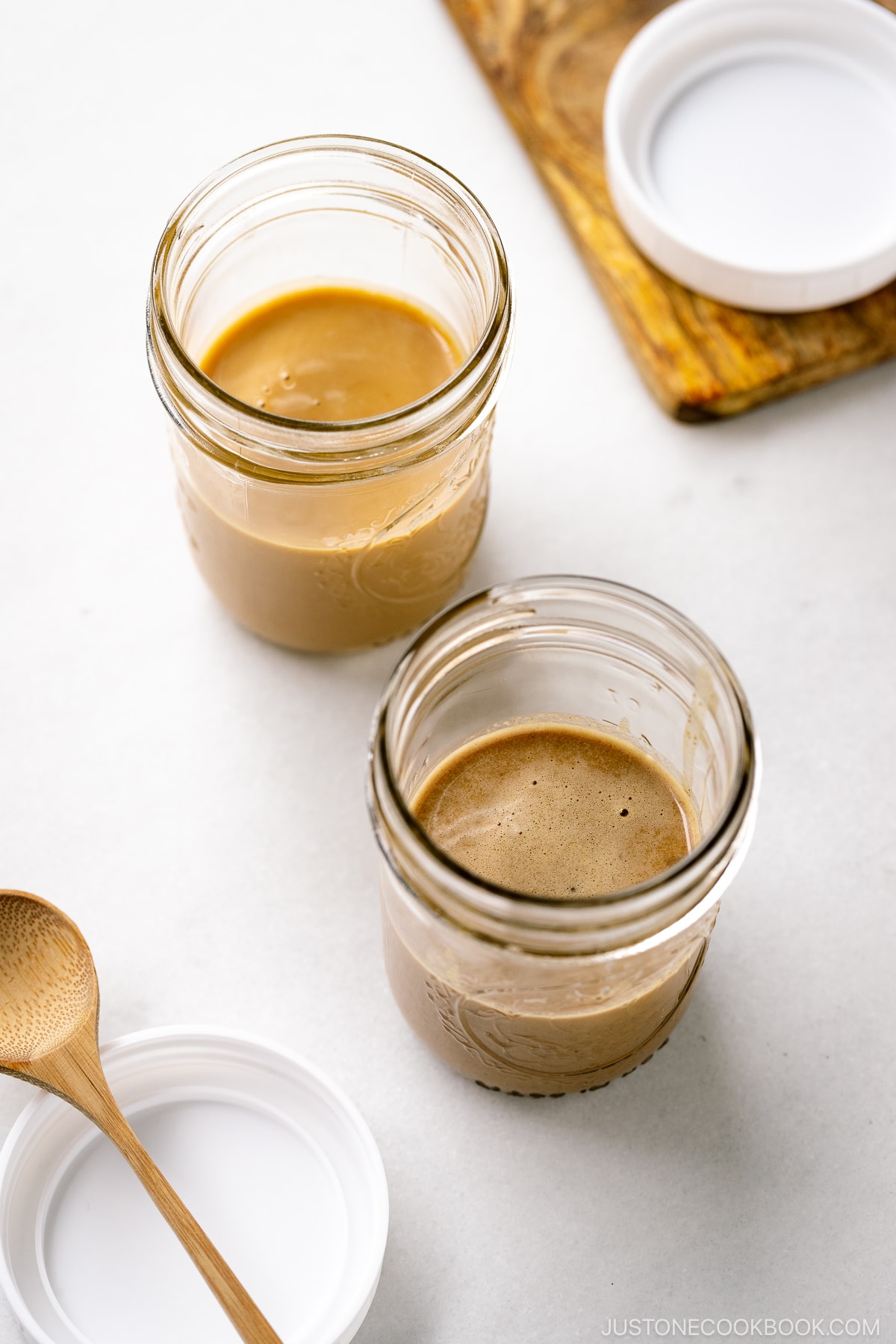
Cooking Tips
- Mix the sesame paste REALLY well. Do this before measuring as the paste separates from the oil while stored in the jar.
- Reduce the amount of the same paste if you’re using a homemade version. Your homemade sesame paste is very rich, flavorful, and thick, so you don’t need as much as the store-bought one. Some high-end sesame paste brands also offer a thick paste, so adjust accordingly.
- You need enough liquid to make a smooth sesame sauce. While you’re gradually adding liquid to the sesame paste, you will see the paste start to solidify, like when chocolate seizes (read this article). Don’t panic. If you add more liquid, it will become smooth again.
- To make a really good sauce, use high-quality sesame paste (or make a homemade version!), make a strong, concentrated dashi, and use just the right amount of salt to bring out the flavors. But go easy with the soy sauce as it will only make the sauce darker by adding more.
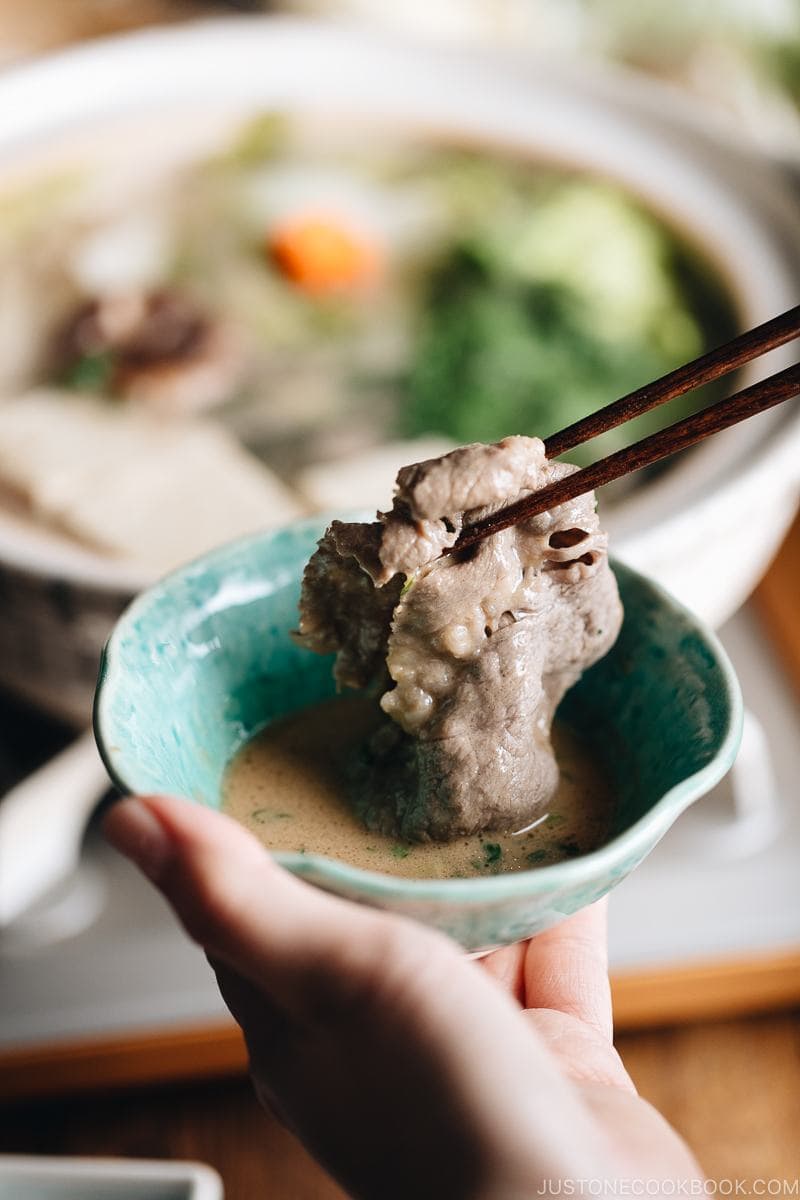
Delicious Ways to Use Goma Dare
Goma Dare is amazing for dipping the ingredients when you enjoy shabu shabu, but don’t stop there! You can certainly use it for many more dishes. Below are some of my favorite ways to enjoy the sauce. If the sauce is too thick for a dish, you can dilute it with dashi. Add more rice vinegar to make it a refreshing salad dressing!
- Shabu Shabu
- Steamed Vegetables or Grilled Vegetables – asparagus, potatoes, cabbage, carrot, and more!
- Cold Tofu or Hot Tofu
- Homemade Udon Noodles
- Somen Noodles
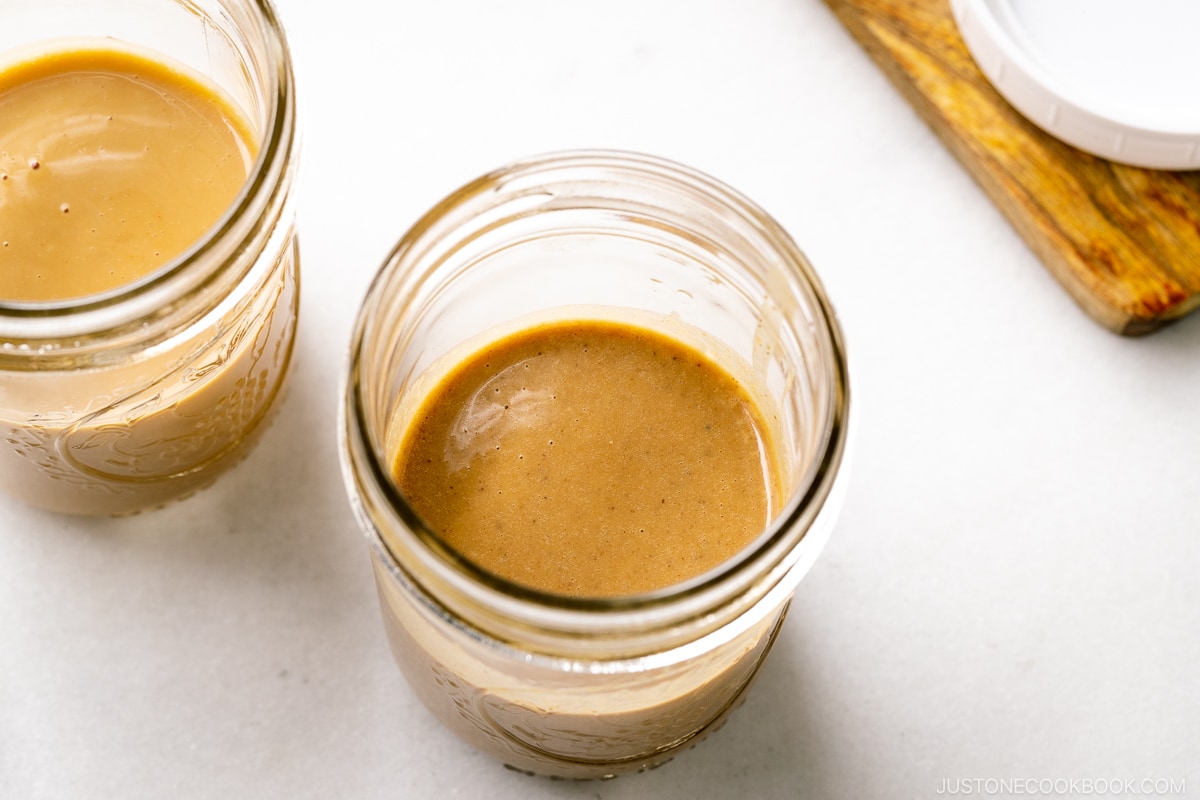
Wish to learn more about Japanese cooking? Sign up for our free newsletter to receive cooking tips & recipe updates! And stay in touch with me on Facebook, Pinterest, YouTube, and Instagram.
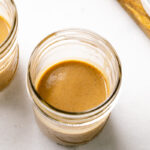
Prep Time: 5 minutes
Total Time: 5 minutes
Servings: 2 (one batch yields ½ cup, or 120 ml)
- 3 Tbsp Japanese sesame paste (neri goma) (if using a thick paste like my Homemade Sesame Paste or Wadaman brand; use 4 Tbsp for a thin and smooth paste like Kadoya brand or tahini)
- 4 tsp sugar
- 1 Tbsp soy sauce
- 4 tsp rice vinegar (unseasoned)
- 2 Tbsp dashi (Japanese soup stock) (I used a dashi packet; or use standard Awase Dashi, dashi powder, or Vegan Dashi; a strong, concentrated dashi makes a more flavorful and delicious sauce)
- ⅛ tsp Diamond Crystal kosher salt
Japanese Ingredient Substitution: If you want substitutes for Japanese condiments and ingredients, click here.
Prevent your screen from going dark
Before You Start…
If you‘re here for the old version of my Sesame Sauce recipe, please see the Notes at the end of the recipe card. However, I highly recommend that you try this revised recipe!
Gather all the ingredients. Please note that one batch yields ½ cup (120 ml), roughly 2 servings as a dipping sauce for Shabu Shabu. If you also serve Ponzu dipping sauce alongside this sauce, then you may have enough for 4 servings.

Mix your sesame paste really, really well before you measure it, as the oil tends to separate in the jar. Then, measure the sesame paste and add it to a small bowl. I used my Homemade Sesame Paste with a thick consistency, so I measured 3 Tbsp for one batch. Use 4 Tbsp if your paste is thinner. Tip: Use a silicone spatula to scrape it off the measuring spoon so you can measure it precisely.
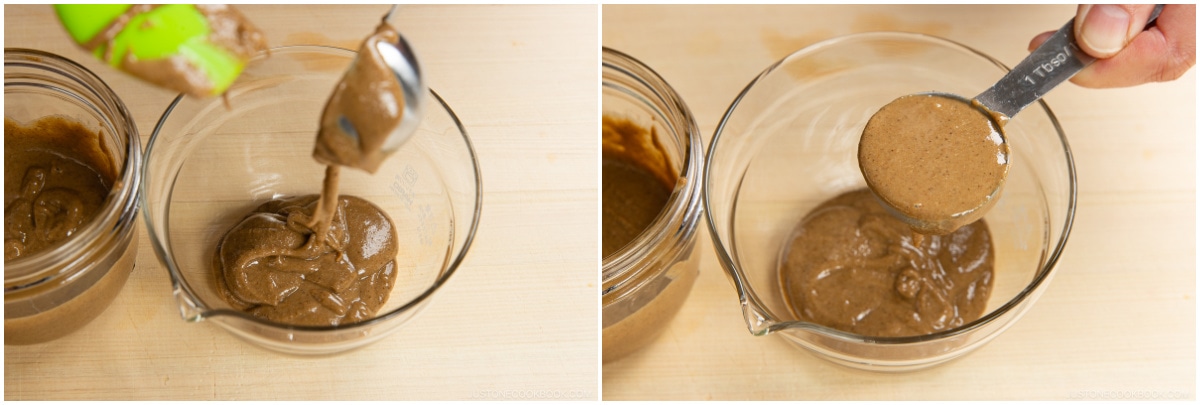
To Make the Sauce
Add 3 Tbsp Japanese sesame paste (neri goma) and 4 tsp sugar to a small bowl and mix well until it is completely dissolved.
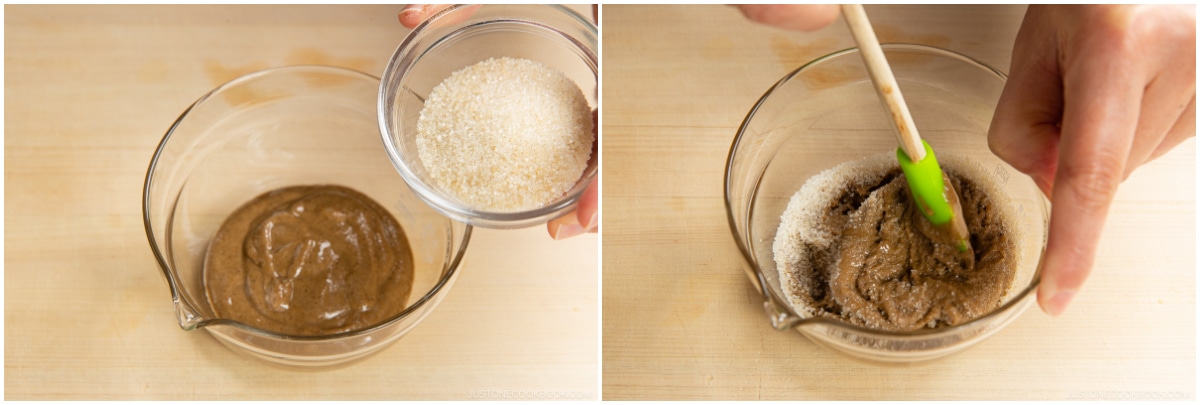
Then, add 1 Tbsp soy sauce and 4 tsp rice vinegar (unseasoned) and mix together. Did your sesame paste clump up? If your paste is different from mine, this may happen. Don‘t worry; we‘ll fix it in the next step. Tip: According to this article, sesame paste is full of carbohydrate molecules that are drawn to the liquid you add. This produces clumps and thickens the paste. The paste will continue to clump and thicken as you gradually stir in more liquid. Once you add enough liquid, though, the sauce eventually will thin out and become smooth.
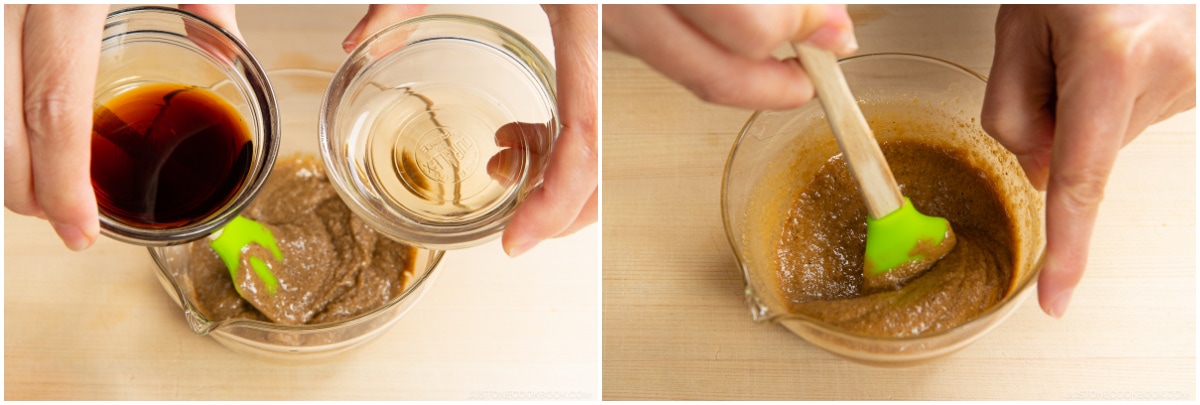
Gradually add 2 Tbsp dashi (Japanese soup stock) to the mixture, drizzling in a little bit at a time. Blend in the dashi completely before adding more. Tip: Why gradually? It‘s extremely hard to blend the thin liquid into the thick paste. It‘s easier to combine when you introduce the liquid slowly.
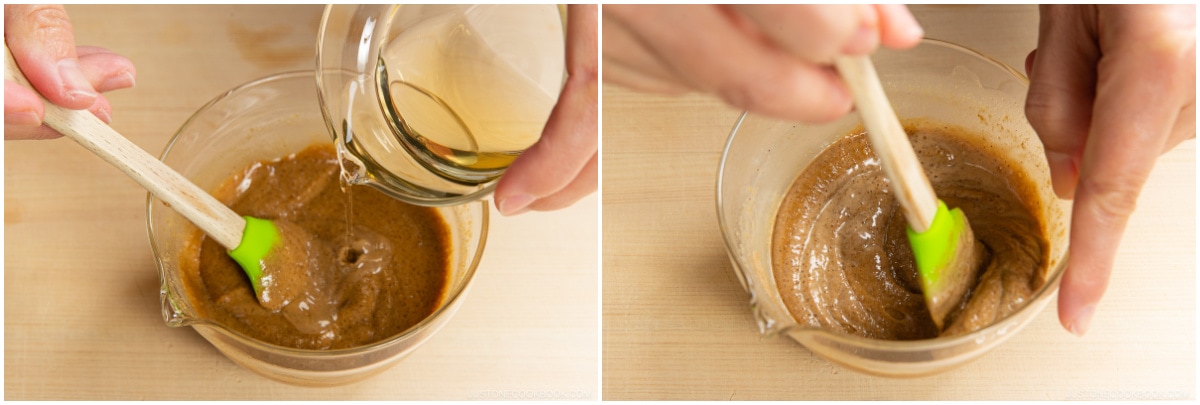
Repeat, adding a bit of the dashi and stirring to combine before adding more. Once you‘ve blended in all the dashi, the consistency of the sauce should be smooth and liquid but still thick.
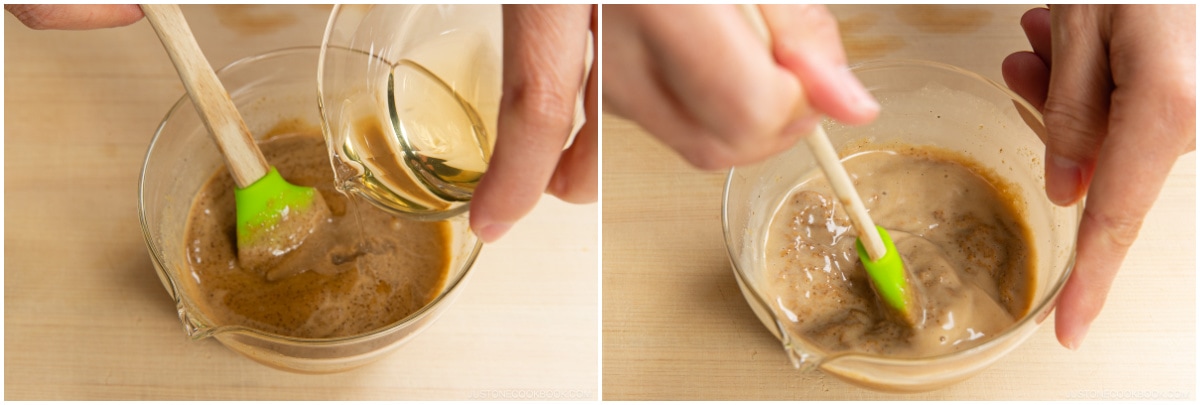
Taste the sauce. Add ⅛ tsp Diamond Crystal kosher salt to taste and stir to combine. You also could add more soy sauce if you wish (this will make the sauce darker). Your Sesame Sauce is now ready to use.
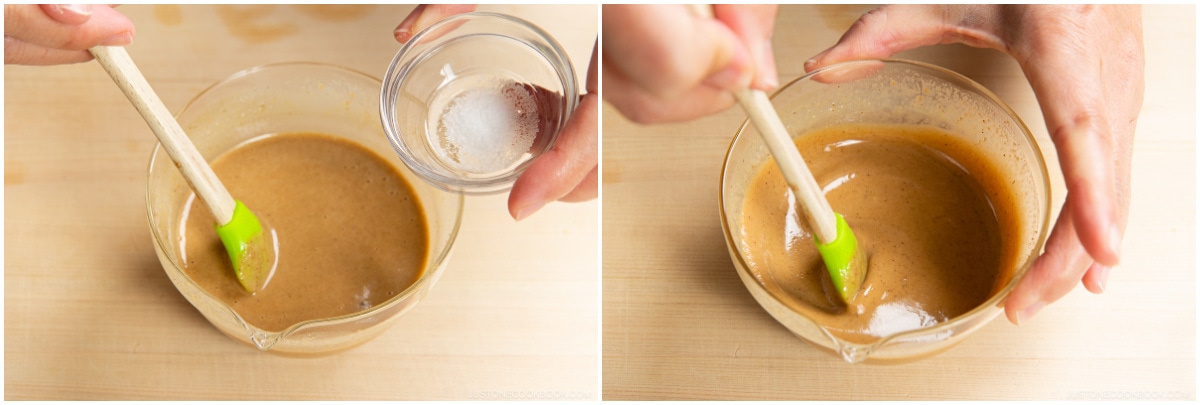
When Using Thin Sesame Paste or Tahini…
Here, I made the sesame sauce using Kadoya brand sesame paste to share how it differs from using homemade paste. You can see that the sauce is much lighter in color. This paste is also thinner, similar to tahini, so I used 4 Tbsp of sesame paste for one batch of this sesame sauce.

To Serve
Use this homemade Sesame Sauce as a dipping sauce for Shabu Shabu. This rich and nutty sauce goes well with all kinds of food, including Steamed Vegetables, Cold Tofu or Hot Tofu, Homemade Udon Noodles, and Somen Noodles. If the sauce is too thick for a dish, you can dilute it with more dashi. Add more rice vinegar to make it a refreshing salad dressing!
To Store
You can keep the sauce in an airtight container and store in the refrigerator for up to 5 days.
My old sesame sauce recipe (Serves 2):
Whisk together 2 Tbsp nerigoma (or tahini), 3 Tbsp sake, 1 Tbsp ponzu, 1 Tbsp miso, 1 tsp sugar, 1 tsp mirin, 1 tsp unseasoned rice vinegar, 1 clove garlic, 1/2 Tbsp neutral-flavored oil, and 1/2 Tbsp roasted sesame oil.
Calories: 284 kcal · Carbohydrates: 19 g · Protein: 9 g · Fat: 21 g · Saturated Fat: 3 g · Polyunsaturated Fat: 10 g · Monounsaturated Fat: 8 g · Sodium: 556 mg · Potassium: 199 mg · Fiber: 5 g · Sugar: 8 g · Vitamin A: 4 IU · Calcium: 415 mg · Iron: 6 mg
Course: Condiments
Cuisine: Japanese
Keyword: sesame seed
©JustOneCookbook.com Content and photographs are copyright protected. Sharing of this recipe is both encouraged and appreciated. Copying and/or pasting full recipes to any website or social media is strictly prohibited. Please view my photo use policy here.
If you made this recipe, snap a pic and hashtag it #justonecookbook! We love to see your creations on Instagram @justonecookbook!
Editor’s Note: This post was originally published on December 2, 2011. It’s been updated with new images and content and the revised recipe in March 2023 and republished on February 21, 2024.